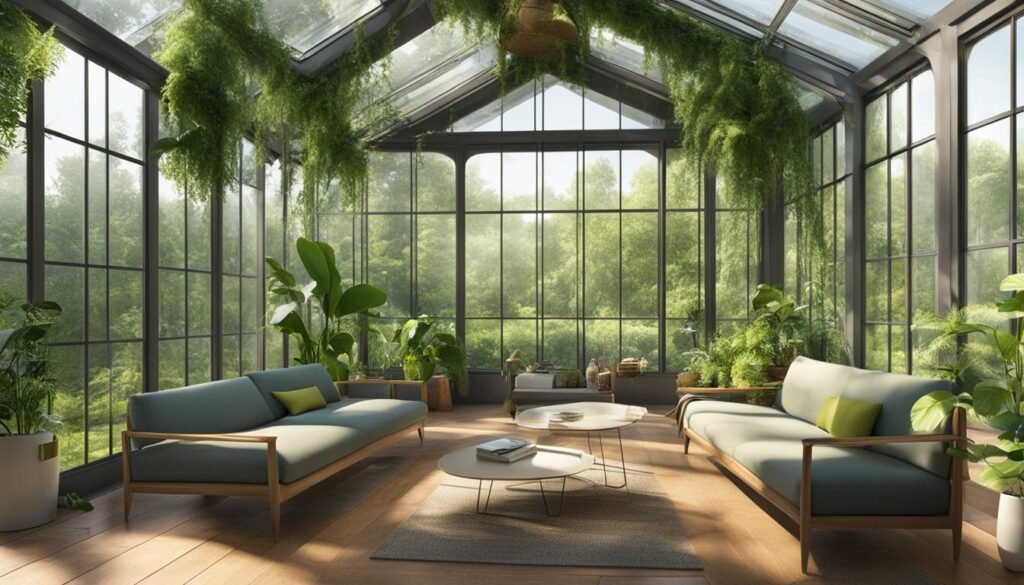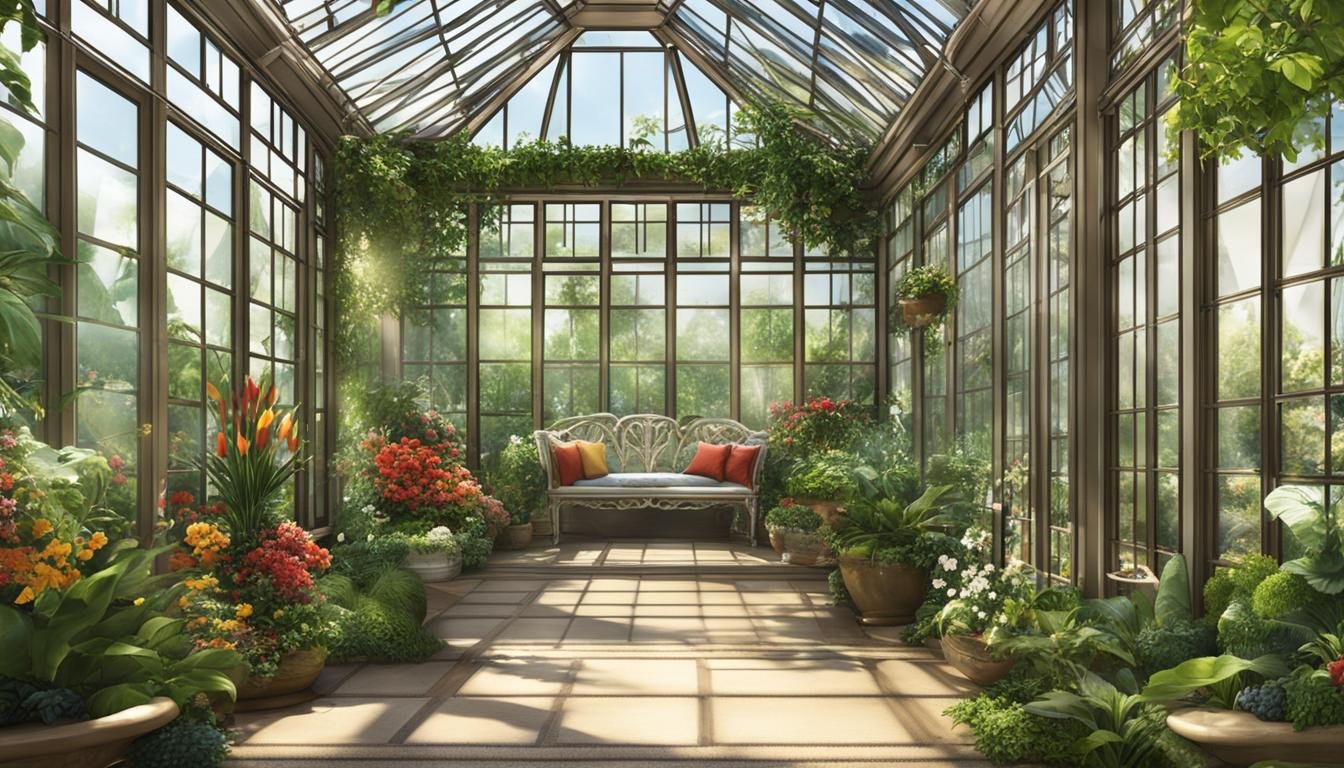A conservatory is a small room, typically attached to a house on one side, that is used as a greenhouse or sun parlor. It originated in the 16th century and became popular in English gardening in the 19th century. Conservatories are designed to let in sunlight, with approximately 50% glass walls and 75% glass roof. They are often mistaken for sunrooms, but there are key differences between the two in terms of purpose, building material, and sunlight exposure.
Key Takeaways:
- A conservatory is a small room attached to a house, used as a greenhouse or sun parlor.
- Conservatories let in sunlight with glass walls and roof, providing a connection with the outdoors.
- They are distinct from sunrooms, offering unique benefits and design options.
- Conservatories can be used for horticulture purposes or as versatile living spaces.
- Materials like glass and polycarbonate allow for maximum sunlight exposure.
Types of Conservatories
When it comes to conservatories, there is no shortage of options. These versatile spaces can serve a variety of purposes, from housing plants to providing extra living areas. Here are some common types of conservatories:
1. Horticultural Conservatories
These conservatories are specifically designed for horticulture purposes. With their ample sunlight exposure and controlled environments, they create the perfect conditions for plants to thrive. Horticultural conservatories often feature specialized heating and ventilation systems to maintain optimal growing conditions.
2. Multi-Purpose Conservatories
Multi-purpose conservatories are designed with versatility in mind. They can serve as additional sitting rooms, dining areas, or even office spaces. These conservatories offer homeowners the flexibility to use the space in various ways, depending on their needs and preferences.
3. Kitchen Extensions
A popular choice for homeowners looking to expand their kitchen space, conservatory kitchen extensions combine the charm of a traditional conservatory with the functionality of a kitchen. These extensions provide a bright and airy environment for cooking and dining, seamlessly blending indoor and outdoor living.
These are just a few examples of the many types of conservatories available. Each type offers unique benefits and can enhance the overall appeal and functionality of a home.
| Type of Conservatory | Primary Purpose |
|---|---|
| Horticultural Conservatories | Providing optimal conditions for plant growth |
| Multi-Purpose Conservatories | Flexible space for various uses |
| Kitchen Extensions | Expanding kitchen space with natural light |
Whether you’re a plant enthusiast, in need of extra space, or dreaming of a sunlit kitchen, there’s a conservatory type that can fulfill your desires. The next section will delve into the benefits of adding a conservatory to your home.
Benefits of Conservatories
Conservatories offer homeowners a range of benefits that can enhance both their living space and their connection with the outdoors. One of the primary advantages of conservatories is the serene environment they provide for relaxation and enjoyment of natural light. With their extensive glass walls and roofs, conservatories offer panoramic views of the surrounding landscape, allowing homeowners to immerse themselves in nature.
Additionally, conservatories can serve as versatile living spaces, such as dining areas or lounge rooms, expanding the usable area of a home. They provide homeowners with the opportunity to bring the beauty of the outdoors indoors, creating a seamless transition between their living space and the surrounding environment.
For horticulture enthusiasts, conservatories are particularly useful as they provide an ideal space for growing plants and allowing them to thrive. The abundant sunlight and controlled climate within a conservatory create the perfect conditions for a wide variety of plants to flourish. Whether it’s a collection of vibrant flowers or a mini herb garden, conservatories offer the opportunity to indulge in gardening passions year-round.
Table: Comparing the Benefits of Conservatories
| Benefits | Conservatories | Sunrooms |
|---|---|---|
| Sunlight Exposure | High (Approximately 75% glass roof) | Lower (More solid roof structures) |
| Versatility | Diverse usage options (e.g., dining area, lounge room) | Mainly used as a relaxation or recreational area |
| Connection with Nature | Seamless transition between indoors and outdoors | Less direct connection |
| Horticultural Potential | Optimal growing conditions for plants | Limited space for plant cultivation |
As shown in the table above, conservatories provide higher sunlight exposure, greater versatility in usage, a stronger connection with nature, and more possibilities for horticulture compared to sunrooms. These advantages make conservatories an appealing choice for homeowners looking to expand their living space while enjoying the benefits of natural light and a connection to the outdoors.

Conservatory Design and Construction
When it comes to designing and constructing a conservatory, there are several important factors to consider. One of the first decisions to make is the design style. From traditional Victorian glasshouses to contemporary geodesic domes, the design options are vast and can be tailored to suit different aesthetic preferences.
Another crucial aspect is the choice of materials. The materials used not only impact the overall look of the conservatory but also its durability. Common options include aluminum, PVCu, and timber, each with its own unique qualities. Selecting the right materials is essential to ensure a conservatory that not only enhances the beauty of your home but also withstands the test of time.
It’s worth noting that building regulations often have specific requirements for conservatories. These may include a minimum percentage of glazed surface area to meet legal definitions. Therefore, it’s important to work with professionals who are knowledgeable about these regulations to ensure compliance.
A conservatory can be an attractive alternative to a traditional home extension. It offers the potential for additional living space at a potentially lower cost. While the exact price of a conservatory can vary depending on factors such as size, materials, and design complexity, it generally presents a cost-effective option for expanding your home.
Lastly, when it comes to conservatories, there is a plethora of ideas and inspirations available to personalize your space. Whether you envision a cozy reading nook, a vibrant horticultural haven, or a stylish entertainment area, the possibilities are endless. Let your creativity shine and transform your conservatory into a space that reflects your unique preferences and needs.
FAQ
What is a conservatory?
A conservatory is a small room, typically attached to a house on one side, that is used as a greenhouse or sun parlor. It consists of approximately 50% glass walls and 75% glass roof to let in sunlight.
What is the difference between a conservatory and a sunroom?
While both are rooms designed to let in sunlight, conservatories are mainly made of glass and polycarbonate plastic, providing more sunlight exposure compared to sunrooms. Conservatories are also often used for horticulture purposes and can serve as extra living spaces, dining areas, or playrooms.
What are the types of conservatories?
Conservatories come in various types and designs, ranging from traditional Victorian glasshouses to modern styles like geodesic domes.
What are the benefits of having a conservatory?
Conservatories provide a serene environment for relaxation and enjoyment of natural light. They offer panoramic views, expand the usable area of a home, and allow homeowners to bring nature indoors. Conservatories are particularly useful for horticulture enthusiasts, providing an ideal space for growing plants.
What factors should be considered when designing and constructing a conservatory?
Factors to consider include the choice of materials such as aluminum, PVCu, or timber, compliance with legal definitions, and cost-effectiveness compared to home extensions. Homeowners can personalize their conservatories with various ideas and inspirations.

